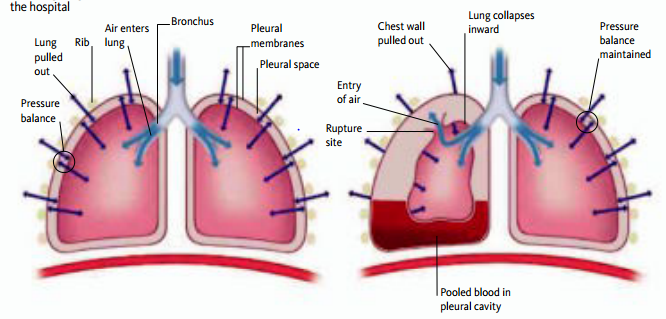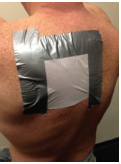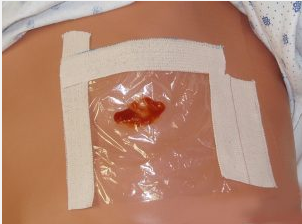First aid for open chest wounds at the scene
Posted by Doctor Pham Duc Luong - Emergency Department - Vinmec Times City International Hospital
An open chest wound is a type of chest trauma that causes a perforation of the chest wall, allowing the pleural space to communicate with the outside air, with or without damage to the internal organs of the chest.
1. What is an open chest wound?
Depending on the anatomical lesions inside the chest, open chest wounds have many diseases with different names and severity - mild, such as: simple open chest wound, heart wound, chest wound - abdomen, abdominal - thoracic wounds, aortic wounds ..., with different diagnostic and treatment characteristics and deep specialties.
Due to severe disturbances in respiratory and circulatory physiology, which can lead to death, open chest wounds are the number 1 priority surgical emergency in first aid, diagnosis, transportation and treatment. .
Due to severe disturbances in respiratory and circulatory physiology, which can lead to death, open chest wounds are the number 1 priority surgical emergency in first aid, diagnosis, transportation and treatment. .
2. What causes open chest wounds?
There are two groups of causes of open chest wounds:
Chest wounds caused by firearms: straight bullets, fragments of bombs, mines, artillery pieces, rockets... Non-fire chest wounds (piercing sharp objects) ): knife, sword, scissors, twigs, broken / broken pieces of vehicles delivered in the accident...
Chest wounds caused by firearms: straight bullets, fragments of bombs, mines, artillery pieces, rockets... Non-fire chest wounds (piercing sharp objects) ): knife, sword, scissors, twigs, broken / broken pieces of vehicles delivered in the accident...
3. Pathogenesis of open chest wounds?
The heart, lungs, and major blood vessels around them are located in the ribcage, protected by the breastbone, spine, and rib cage. The rib cage also extends far enough down to protect organs such as the liver and spleen located in the upper abdomen.
If a sharp object penetrates the chest wall, there can be serious damage to organs in the chest and upper abdomen and this can lead to shock. The lungs are particularly susceptible to injury, either from damage or from a wound that perforates the two layers of pleura (parietal and visceral) that surround and protect each lung. Then air can get between the membranes and put pressure on the lungs and the lungs can collapse — a condition called a pneumothorax.
The pressure around the affected lung can progressively affect the uninjured lung and the victim becomes increasingly difficult to breathe. In tension pneumothorax, this build-up of pressure can prevent the heart from filling with blood properly, impairing circulation and causing shock. Sometimes, blood builds up in the pleural space (hemothorax) and puts pressure on the lungs.
In the open chest wound, when there are physiological - anatomical injuries such as chest wall perforation, hemothorax - pneumothorax, it will lead to respiratory failure due to respiratory physiological disorders, typically “reverse respiration” and “mediastinal sway”
If a sharp object penetrates the chest wall, there can be serious damage to organs in the chest and upper abdomen and this can lead to shock. The lungs are particularly susceptible to injury, either from damage or from a wound that perforates the two layers of pleura (parietal and visceral) that surround and protect each lung. Then air can get between the membranes and put pressure on the lungs and the lungs can collapse — a condition called a pneumothorax.
The pressure around the affected lung can progressively affect the uninjured lung and the victim becomes increasingly difficult to breathe. In tension pneumothorax, this build-up of pressure can prevent the heart from filling with blood properly, impairing circulation and causing shock. Sometimes, blood builds up in the pleural space (hemothorax) and puts pressure on the lungs.
In the open chest wound, when there are physiological - anatomical injuries such as chest wall perforation, hemothorax - pneumothorax, it will lead to respiratory failure due to respiratory physiological disorders, typically “reverse respiration” and “mediastinal sway”

Hình ảnh hô hấp bình thường và phổi bị thu gọn
| Hô hấp bình thường | Phổi bị thu gọn (bên phải) |
|
Ở thì hít vào: thành ngực nở ra, cơ hoành hạ xuống, sẽ kéo phổi nở ra theo, dẫn đến giảm áp suất phế nang, và không khí tự đi vào phổi. Ở thì thở ra: thành ngực xẹp xuống, cơ hoành nâng lên, sẽ ép xẹp nhu mô phổi, làm tăng áp suất phế nang và không khí tự đi ra ngoài qua đường hô hấp. |
Không khí từ phổi phải và/hoặc từ môi trường đi vào khoang màng phổi xung quanh phổi; máu tích tụ trong khoang màng phổi gây thay đổi cân bằng áp suất. Phổi co lại khỏi thành ngực. |
4. Signs of open chest wound?
Shortness of breath and chest pain: continuous and increasing in nature, very severe if the chest wound is still open.
Victim has obvious discomfort: struggling, agitated, anxious...
There are signs of hypoxia, including purple lips, bluish-gray skin color (blue-violet)
May also found other signs:
Coughing up red blood foam. A "click" sensation when pressing on the skin around the site of the wound due to subcutaneous emphysema. Foam blood through the wound according to the patient's breathing. A “hist” sound: The sound of air being drawn into the chest when the victim inhales and hissed out from the wound when the patient exhales. Veins in the neck float. Identify the cause of injury: eg knife-scissors stab, slash, sharp object puncture in an accident.
Victim has obvious discomfort: struggling, agitated, anxious...
There are signs of hypoxia, including purple lips, bluish-gray skin color (blue-violet)
May also found other signs:
Coughing up red blood foam. A "click" sensation when pressing on the skin around the site of the wound due to subcutaneous emphysema. Foam blood through the wound according to the patient's breathing. A “hist” sound: The sound of air being drawn into the chest when the victim inhales and hissed out from the wound when the patient exhales. Veins in the neck float. Identify the cause of injury: eg knife-scissors stab, slash, sharp object puncture in an accident.
5. What should be done to give first aid to a victim with an open chest wound?
Painful, bleeding, and potentially fatal, victims with open chest wounds require immediate first aid to relieve bleeding, pain, and stabilize the victim until a professional emergency team is reached. Treating an open chest wound requires quick, precise action.
The purposes of open chest wound first aid are to cover the wound and maintain respiration, minimize shock, and arrange for emergency transport to the hospital.
5.1 Check the safety of the environment Victims with open chest injuries can be encountered in a traffic accident, stabbing/slashing, assassination, bomb explosion... Therefore, before approaching the scene, must assess the safety of the environment. Avoid making yourself a potential victim by intervening or getting close to attackers, scenes where there is a high risk of explosives or accidents. Only approach the victim when you have determined that it is safe to do so. While waiting takes precious time to give first aid to a victim, having more people injured is not conducive to rescuing anyone.
5.2 Call for immediate emergency help If you are the only one around, use your phone to call for help as a priority. If you don't have your phone with you, try to find a passerby or a store nearby. You want to help the victim as quickly as possible, but the most helpful thing you can do is seek professional medical help for the victim as soon as possible.
If the environment is unsafe and you cannot safely reach the victim, use that time to call emergency services.
5.3 Lay the victim down Before you do anything else to deal with the stab wound, have the person lie down on the ground. This will make it easier to stabilize the victim, especially if they begin to feel light-headed or unconscious.
For comfort, place a jacket or backpack under the victim's head. Also, if there are other people around, ask one of them to sit with their head on the person's lap and talk to them. This will calm the victim and help him stay calm.
The purposes of open chest wound first aid are to cover the wound and maintain respiration, minimize shock, and arrange for emergency transport to the hospital.
5.1 Check the safety of the environment Victims with open chest injuries can be encountered in a traffic accident, stabbing/slashing, assassination, bomb explosion... Therefore, before approaching the scene, must assess the safety of the environment. Avoid making yourself a potential victim by intervening or getting close to attackers, scenes where there is a high risk of explosives or accidents. Only approach the victim when you have determined that it is safe to do so. While waiting takes precious time to give first aid to a victim, having more people injured is not conducive to rescuing anyone.
5.2 Call for immediate emergency help If you are the only one around, use your phone to call for help as a priority. If you don't have your phone with you, try to find a passerby or a store nearby. You want to help the victim as quickly as possible, but the most helpful thing you can do is seek professional medical help for the victim as soon as possible.
If the environment is unsafe and you cannot safely reach the victim, use that time to call emergency services.
5.3 Lay the victim down Before you do anything else to deal with the stab wound, have the person lie down on the ground. This will make it easier to stabilize the victim, especially if they begin to feel light-headed or unconscious.
For comfort, place a jacket or backpack under the victim's head. Also, if there are other people around, ask one of them to sit with their head on the person's lap and talk to them. This will calm the victim and help him stay calm.

Hãy cố gắng liên hệ với 115 sớm nhất để có sự hỗ trợ y tế chuyên nghiệp
6. Examine the victim and determine the extent of the injury
6.1 Check the casualty's airway, breathing, and circulation. Make sure the victim's airway is not blocked. Listen for breathing and observe the movement of the victim's chest. Check the victim's pulse to make sure the heart is still beating. If the victim has stopped breathing, perform CPR. If the person is awake, start working but also talk to them to calm them down and help slow their heart rate. If possible, try to keep the wound out of sight. 6.2 Exposing the area of injury You may need to cut/tear off the victim's clothing to properly identify the wound(s). Try to find and identify all injuries before starting treatment. Lesions are sometimes obscured by clothing, blood or other fluids, and even mud, depending on where the victim is found. Care should be taken to do this gently, being careful not to cause further pain to the victim.
However, if you notice an injury that is clearly serious and needs urgent treatment, you should treat it immediately. A severe wound can be a wound that bleeds continuously and profusely or a wound that oozes blood like a geyser. Splashing blood is usually a sign that the wound has touched an artery.
6.3 Bandage on an open chest wound Cover the wound and surrounding area with a clean, non-exhaust material such as kitchen foil, a plastic bag, or cling film. Cover the wound with only three edges and leave one edge so that air from the pleural cavity can escape from one side of the dressing and prevent air from the environment from entering the pleural space. If air enters the pleural space, the lung can collapse.
However, if you notice an injury that is clearly serious and needs urgent treatment, you should treat it immediately. A severe wound can be a wound that bleeds continuously and profusely or a wound that oozes blood like a geyser. Splashing blood is usually a sign that the wound has touched an artery.
6.3 Bandage on an open chest wound Cover the wound and surrounding area with a clean, non-exhaust material such as kitchen foil, a plastic bag, or cling film. Cover the wound with only three edges and leave one edge so that air from the pleural cavity can escape from one side of the dressing and prevent air from the environment from entering the pleural space. If air enters the pleural space, the lung can collapse.

Hình ảnh băng vết thương ngực hở

Hình ảnh băng vết thương ngực hở
Note: Never remove the punctured object from the wound.
Leave the puncture object in the wound if it is still there and be very careful not to move it as this may cause further damage. At this point, the puncture plays a real role in stopping the bleeding. Pulling it out increases blood loss, while pushing it in can cause further injury to internal organs. You need to apply pressure around the wound and immobilize the puncture as best you can.
Leave the puncture object in the wound if it is still there and be very careful not to move it as this may cause further damage. At this point, the puncture plays a real role in stopping the bleeding. Pulling it out increases blood loss, while pushing it in can cause further injury to internal organs. You need to apply pressure around the wound and immobilize the puncture as best you can.
7. Follow the victim
While waiting for the emergency team to arrive, continue to monitor the victim's airway, breathing, and circulation. Look for and treat symptoms of shock. Symptoms of shock include cold, pale skin, rapid pulse or rapid breathing, nausea or vomiting, dizziness or fainting, and increased anxiety or agitation.
If you suspect the victim may be in shock, loosen tight clothing and warm the victim. Try to keep the victim still. If possible, raise the victim's legs to make it easier for blood to flow to the heart.
If the victim has a change of consciousness, you need to act quickly. Place victim in a safe side-lying position. Do not place the victim in a supine position with associated spinal cord and cervical spine injuries. Monitor the person's breathing.
If victim is unconscious, stops breathing, place casualty on back and perform CPR.
Monitor and record victim's vitals — level of consciousness, breathing, and pulse/heart rate—until emergency help arrives.
Vinmec International General Hospital is a high-quality medical facility in Vietnam with a team of highly qualified medical professionals, well-trained, domestic and foreign, and experienced.
A system of modern and advanced medical equipment, possessing many of the best machines in the world, helping to detect many difficult and dangerous diseases in a short time, supporting the diagnosis and treatment of doctors the most effective. The hospital space is designed according to 5-star hotel standards, giving patients comfort, friendliness and peace of mind.
If you suspect the victim may be in shock, loosen tight clothing and warm the victim. Try to keep the victim still. If possible, raise the victim's legs to make it easier for blood to flow to the heart.
If the victim has a change of consciousness, you need to act quickly. Place victim in a safe side-lying position. Do not place the victim in a supine position with associated spinal cord and cervical spine injuries. Monitor the person's breathing.
If victim is unconscious, stops breathing, place casualty on back and perform CPR.
Monitor and record victim's vitals — level of consciousness, breathing, and pulse/heart rate—until emergency help arrives.
Vinmec International General Hospital is a high-quality medical facility in Vietnam with a team of highly qualified medical professionals, well-trained, domestic and foreign, and experienced.
A system of modern and advanced medical equipment, possessing many of the best machines in the world, helping to detect many difficult and dangerous diseases in a short time, supporting the diagnosis and treatment of doctors the most effective. The hospital space is designed according to 5-star hotel standards, giving patients comfort, friendliness and peace of mind.
Để đặt lịch khám tại viện, Quý khách vui lòng bấm số HOTLINE hoặc đặt lịch trực tiếp TẠI ĐÂY. Tải và đặt lịch khám tự động trên ứng dụng MyVinmec để quản lý, theo dõi lịch và đặt hẹn mọi lúc mọi nơi ngay trên ứng dụng.
References:
Gina M. Piazza et all: Penetrating chest wound, First aid manual: the step by step guide for everyone, Fifth edition first published in the United States in 2014 by DK Publishing, 4th floor, 345 Hudson Street, New York, NY 10014. Julie M Winkle, Eric Legome: Initial evaluation and management of penetrating thoracic trauma in adults, up to date, last updated: May 05, 2020. https://www.uptodate.com/contents/initial- evaluation-and-management-of-penetrating-thoracic-trauma-in-adults?search=prehospital%20management%20of%20the%20penetrating%20chest%20wound&source=search_result&selectedTitle=3~150&usage_type=default&display_rank=3
Gina M. Piazza et all: Penetrating chest wound, First aid manual: the step by step guide for everyone, Fifth edition first published in the United States in 2014 by DK Publishing, 4th floor, 345 Hudson Street, New York, NY 10014. Julie M Winkle, Eric Legome: Initial evaluation and management of penetrating thoracic trauma in adults, up to date, last updated: May 05, 2020. https://www.uptodate.com/contents/initial- evaluation-and-management-of-penetrating-thoracic-trauma-in-adults?search=prehospital%20management%20of%20the%20penetrating%20chest%20wound&source=search_result&selectedTitle=3~150&usage_type=default&display_rank=3
Bài viết này được viết cho người đọc tại Sài Gòn, Hà Nội, Hồ Chí Minh, Phú Quốc, Nha Trang, Hạ Long, Hải Phòng, Đà Nẵng.






